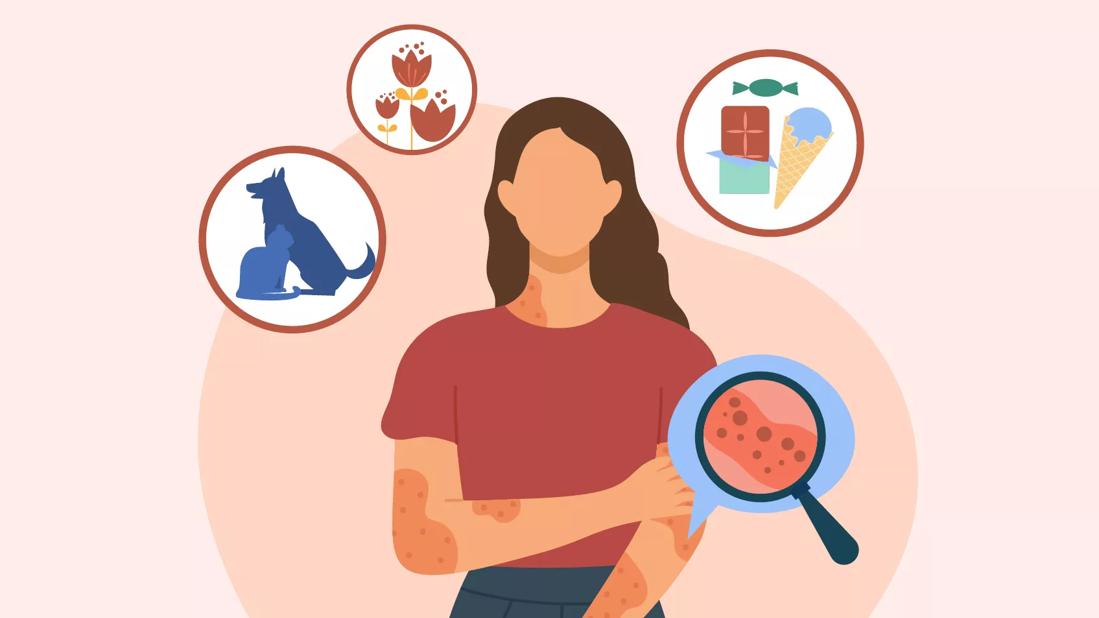How to handle breathing difficulties, rashes, hives and more

Pollen, dust, animal dander, nuts, shellfish and other foods — these can all cause an allergic reaction in susceptible people.
Advertisement
Cleveland Clinic is a non-profit academic medical center. Advertising on our site helps support our mission. We do not endorse non-Cleveland Clinic products or services. Policy
Symptoms can range from being mildly uncomfortable and annoying to serious and life-threatening. So, it’s good to know what to do if you or someone you’re with has an allergic reaction.
Allergist and immunologist Anuja Kapil, MD, breaks down what to look for in an allergic reaction and how to handle different situations.
When you eat, breathe in or touch something that you’re allergic to, your immune system produces histamines to deal with the bothersome substance.
But while your body’s intentions might be good, that natural response can trigger symptoms like:
Given the range of reactions to allergens, treatment recommendations can vary from immediately calling 911 for help to simple at-home remedies. Different situations require vastly different responses.
So, let’s break it down by some of the more common symptoms.
Don’t delay getting medical attention for anaphylaxis, which is when allergic reactions take a severe turn. Dial 911 — and do it ASAP.
“Calling 911 is better than driving to the emergency department,” says Dr. Kapil. “Emergency medical technicians in an ambulance have protocols and access to treatments specifically for severe allergic reactions.”
Advertisement
In addition, many people with potentially life-threatening allergies carry an injector that can deliver a dose of epinephrine (adrenaline). This shot of adrenaline — typically delivered in your thigh — can help reverse severe allergic reactions while you await medical care.
Use the epinephrine injector if a reaction is serious. Your or someone’s life may depend on taking quick action.
Food allergies are the most common trigger of anaphylaxis. Severe reactions also can be brought on insect stings, latex or medications.
An allergic reaction that makes it difficult to breathe can create a sense of impending doom, says Dr. Kapil. Understand that an anaphylactic reaction can be an intense situation. It’s important to remain calm.
Wash the affected skin area with mild soap and lukewarm water to remove the allergen. Afterward, apply hydrocortisone cream or lotion. Calamine lotion and cool compresses may also bring relief.
If your itchiness is severe, your rash doesn’t go away or you see signs of infection, call your doctor.
A few other tips:
The good news? Hives will subside in time. Meanwhile, it helps to:
When you have multiple allergic symptoms, a nasal spray or over-the-counter antihistamine such as loratadine (Claritin®) can treat them.
Dr. Kapil advises against using products that have a sedative effect, such as Benadryl®.
Knowing what causes your allergic reaction can help you avoid future situations. It could even connect the dots to other potential allergens, too. For example:
So follow up with your doctor and ask about allergy testing, advises Dr. Kapil. “Testing can help pinpoint the reason behind your reaction,” he says. “Better yet, it might help keep you away from what triggered it.”
Advertisement
Learn more about our editorial process.
Advertisement

Most antihistamines, like Zyrtec, are OK, but avoid decongestants for at least the first trimester

Drowsiness is a side effect of inflammation, disrupted sleep and, sometimes, your allergy medicine

If you’re sensitive to aspirin or other salicylates, limiting exposure is the best remedy

Mold exposure can cause allergic reactions, asthma and skin rashes

If allergies have you coughing and sniffling all night, try showering before bed, keeping the windows closed and propping your head up

If allergies make your mornings a slog, consider closing the windows and showering at night

When the trees start to bloom, your allergies can come to life — medications, closing the windows and keeping clean can help

Water, touch, sunlight, physical activity and cold are some of the rarest allergies

The best parenting style balances enforcing rules and showing plenty of love

Tips include cutting back on sugar, focusing on exercise and managing stress

It can be harder to let go when you’ve invested time, energy and emotions — but it might be the healthier choice long term